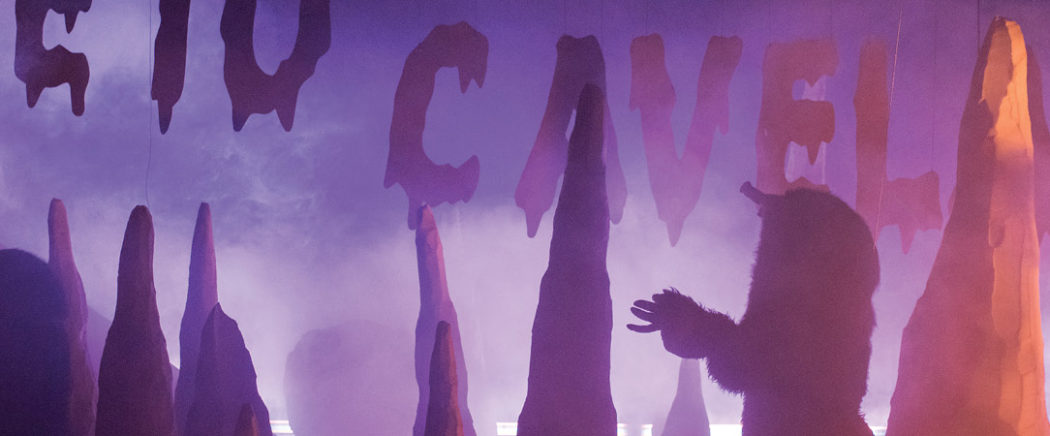Philippe Quesne, a visual artist who collaborates constantly with thinkers and philosophers, is (for my money) France’s most exciting contemporary theater-maker. He is a vital artist for the Anthropocene, this new era into which we have stumbled.
The Night of the Moles, as I jotted down on a piece of paper after first seeing it in 2016, is “like getting a very satisfying injection of materialist philosophy cut with something vaguely psychotropic, leaving the spectator with the impression that she now understands something we might call Mole-Paw-Being.” Which is to say that watching seven-foot-tall moles dig tunnels and shift matter about, play the theremin and the electric guitar, copulate, live, die, grieve, fight, and wrestle with huge earthworms, will put you in an (upbeat and riotous) altered mental state (such is the purpose of theater) and leave you with a deep and intuitive sense of how human and non-human agencies commingle with and in the matter of which our Earth is hewn. It is like going to a party, having a good time, and then returning home to realize that you now possess a visceral grasp of ecological thought.
To situate The Night of the Moles, we can recall that at the Théâtre des Amandiers in Nanterre, the state-owned theater that Quesne directs on the outskirts of Paris, The Night of the Moles was in November 2016 part of a festival titled “Welcome to Caveland,” an extravaganza that the festival booklet described as “an artistic swarming that gets its inspiration from undergrounds and from caves, from places hidden and clandestine, from alternative and subterranean spaces that are ‘underground’ in all senses of the word, places close to E/earth and to matter, but which also give rise to dream-like visions.” Also featured in the festival were Cécile Fraysse’s playful Earthworm Island and Apichatpong Weerasethakul’s Fever Room, a film projected on four screens and subsequently on the smoke that fills the room, all to be watched lying on the floor alongside a bunch of strangers doing the same. As with The Night of the Moles, you are here, in the midst of it, nowhere else, and the sky is falling down on your head, and you’re carried off down a tunnel. And you’re in caves, and then you’re here and you’re not sure where here is. This is being thrown into the ecological here and now. Nature is no longer over-there.
Also featured in “Welcome to Caveland” – and here, we can appreciate what the shot of materialist philosophy changes in our grasp on the world – were the rock-star philosopher of the Anthropocene, Bruno Latour, and thinker/theater director Frédérique Aït-Touati, who also recently collaborated on “Inside,” which NYU brought to Broadway’s Romulus Linney Courtyard Theatre in 2018 as part of the Center for French Language and Cultures’s “French Natures” conference-festival. In both cases: a shot of materialist philosophy (Latour) + something psychotropic (theater). It is fair to say that, while being much more, The Night of the Moles at once pre-dates, anticipates, translates, and celebrates Latour’s most recent book, Où atterrir? (to which was given the strange and misleading English-title Down to Earth), which hypothesizes that, to live in the Anthropocene, we must get rid of notions like global and local, in preference for the terrestrial, i.e. for the multiple agencies that commingle in the critical zone, that envelope of the biosphere that Lovelock nicknamed “Gaia’s skin.” We can only see our globe if we are astronauts, God, or if we imagine ourselves looking back from nowhere. That is no way to live, no way to do politics. Better, for sure, to think – or rather, to be and to sense – like a mole.
Having and watching moles move about the stage on scooters and play the theremin is not just theater, but philosophical and political theater. Read closely the thirty-one pages of the document known as the Paris Agreement, produced within the United Nations Framework Convention on Climate Change (COP 21) in December 2015. On one hand, you will come across the word “emission” a total of ninety-eight times. On the other hand, you will not find the words “extraction” or “mining” anywhere, not once. A mole, though fabled to be blind, would never be guilty of such an oversight. As Latour recently put it talking about his exhibitions at the ZKM (e.g. Reset Modernity!), Quesne’s play does not seek to “illustrate” philosophical ideas; rather, “it plunges philosophical ideas into the competing field of much more powerful works of art.” After seeing The Night of the Moles, everyone knows for sure that we live not just on Earth, but with it.
Phillip John Usher is the Chair of the Department of French Literature, Thought and Culture at NYU. He is most recently the author of “Exterranean: Extraction in the Humanist Anthropocene” (Fordham University Press, 2019).
